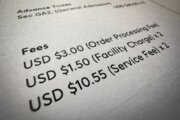One way to look at dividend investing is that it’s a simpler path to cash flow than real estate or other means and takes less time to pull off. After you research dividend stocks and invest in a few shares, the dividend payments start accumulating.
However, corporations are not obligated to continue their dividend programs. Dividends can get cut or eliminated at any moment. For example, many airline companies suspended their dividends at the start of the pandemic and have not reinstated them. Big names such as AT&T Inc. (T), Healthpeak Properties Inc. (PEAK) and Wynn Resorts Ltd. (WYNN) each made recent cuts to their dividends.
[Sign up for stock news with our Invested newsletter.]
Companies prefer to increase their dividends each year and reward shareholders. These actions give shareholders more reasons to hold onto shares, but declining earnings can force a company to suspend or cut the dividend.
The dividend yield doesn’t tell you if a cut or suspension is coming. This number doesn’t even inform you about a stock’s health. So experts recommend that investors look at the dividend payout ratio to assess a dividend’s durability.
The dividend payout ratio assesses the dividends paid to shareholders in relation to a company’s net earnings, and it is stated as a percentage. A high dividend payout ratio can indicate that a stock is risky and has limited upside.
Investors can use the dividend payout ratio to discover the state of a company’s business model. Understanding key details like this can help you choose the right dividend stocks for you:
— What is a dividend payout ratio?
— How to calculate a dividend payout ratio.
— How to analyze a dividend payout ratio.
— Low vs. high dividend payout ratios.
— Dividend payout ratios vary by sector.
What Is a Dividend Payout Ratio?
A dividend payout ratio is a useful metric that reveals a dividend’s sustainability. It measures the percentage of net income that goes to the dividend program. Shareholders receive these profits, which they can accept as cash or reinvest into additional shares.
The dividend payout ratio, or simply the payout ratio, indicates a dividend’s margin of safety. If a company pays a $110 million dividend but only shows $100 million in net income, the company has to borrow money or use cash from previous quarters to distribute the dividend.
A dividend payout ratio can tell you a lot about a stock, says Todd Lowenstein, managing director and chief equity strategist at HighMark Capital Management. “Companies which pay predictable dividends generally have stable business models that throw off large amounts of excess cash beyond the needs of the underlying business. Dividend payout ratios are an important factor when handicapping the safety and sustainability of company dividends.”
The dividend payout ratio will highlight an unsustainable dividend before a corporation suspends or cuts the dividend. A ratio close to 100% may indicate the company is struggling to keep up and may have to take out debt to finance the dividend, a telltale sign that the dividend may soon get paused or cut.
[How to Analyze a Stock’s Dividend]
How to Calculate a Dividend Payout Ratio
Once you’ve determined the annual dividends that a company has paid, the dividend payout ratio calculation is straightforward. Divide the company’s dividend payments by its net income. For instance, if a company earns $500 million and pays a $200 million dividend, the dividend payout ratio is 40%. The complete calculation is below:
Dividend payments / net income = dividend payout ratio
$200 million / $500 million = 40% dividend payout ratio
To find the dividend payments for this calculation, look for that information on the company’s cash flow statement or in the dividend announcement posted in the section for investors on its website. It’s also possible to calculate dividends paid by subtracting the change in the company’s retained earnings over the course of the year from its annual net profit. These numbers can be found on the company’s starting and ending balance sheets for the year and in the income statement that is part of its annual report.
You can also calculate the dividend payout ratio by taking the dividend per share and dividing by the earnings per share, or EPS:
Dividend per share / earnings per share = dividend payout ratio
$4 annual dividend per share / $10 EPS = 40%
A 40% payout ratio would be favorable for an investor because a payout ratio below 50% gives a company enough flexibility to reward shareholders while reinvesting in new projects. Some profitable companies, such as Alphabet Inc. (GOOG, GOOGL), do not offer dividends and prefer to reinvest the retained earnings into growth initiatives.
These reinvestments can increase the stock’s price, but shareholders will need another solution if they prioritize dividends.
A dividend payout ratio above 50% isn’t necessarily a bad thing. Some of the dividend aristocrats, companies in the S&P 500 that have raised their dividends for at least 25 consecutive years, have payout ratios above 50%. While a high dividend payout ratio increases cash flow, a payout ratio too close to 100% can lead to problems in the future.
An excessive dividend payout ratio can reflect increased risk, says Ayako Yoshioka, a chartered financial analyst and senior portfolio manager at Wealth Enhancement Group. “A high dividend payout ratio becomes problematic because it implies that a significant portion of net income is being paid out to the shareholder and not retained for reinvestment back into the business,” Yoshioka says.
A company with a lower payout ratio will likely have a lower yield, but some of these same companies have greater share price appreciation. Dividend investors should look at an asset’s total returns instead of only looking at the yield. Total returns include dividends and asset appreciation.
How to Analyze a Dividend Payout Ratio
The dividend payout ratio isn’t the only factor investors should look at to assess a dividend stock’s sustainability, but it is a good starting point. The underlying business model, earnings growth and profit margin are some other metrics to look at when analyzing a stock. If earnings continue to increase and profit margins expand, it can be a good sign for the dividend’s health.
Before analyzing a dividend payout ratio, it’s important to clarify your portfolio goals. Income investors and growth investors look for different payout ratios.
Income investors look for higher dividend payout ratios to maximize cash flow. A 60% dividend payout ratio, all else being equal, results in double the dividends of a 30% payout ratio. Higher dividend payout ratios push up dividend yields, which means an income investor needs less capital to achieve their cash flow goals.
If an income investor wants to earn $12,000 each year from dividends, $600,000 should be invested at a minimum of a 2% yield. However, investors can earn $12,000 per year from dividends if they invest $300,000 at a 4% yield. Dividend yields don’t tell the entire story, but a dividend stock with a 4% yield likely has a higher payout ratio than a stock with a 2% yield.
Low vs. High Dividend Payout Ratios
Growth investors generally prefer a smaller dividend payout ratio because it means earnings are getting reinvested in the company. That reinvestment can fund new company segments or go into share-buyback programs.
Some investors were happy that Intel Corp. (INTC) cut its dividend earlier this year because those cuts gave the company an additional $4 billion per year to reinvest into the company. That decision partially stemmed from declining revenue and earnings, but reinvestments can increase share prices and allow investors to save on taxes while growing their portfolios. Though investors can postpone tax payments on share-price gains by holding onto their shares, dividends get taxed in the year they are distributed.
A low dividend payout ratio doesn’t result in high yields now, but it gives the company a greater buffer to maintain and raise the dividend each year.
“Lower payouts often lead to continued room for dividend growth while maintaining more control over uses of future excess cash flows,” says Allen Thuma, portfolio manager and research analyst at Buckingham Advisors.
High payouts, Thuma says, are problematic when the company loses control of what to do with the excess cash flows.
Dividend Payout Ratios Vary by Sector
Generally a high payout ratio may limit a company’s ability to reinvest earnings, but some sectors are known for high payout ratios. Utilities and consumer staples companies have higher dividend payout ratios than firms in most sectors due to high earnings and reliable cash flow.
Dividend-paying corporations in tech have lower payout ratios because these companies have to reinvest more of their earnings to stay relevant in the industry and achieve growth.
While industries have varying dividend payout ratio norms, some stocks are outliers. Reviewing the payout ratios of multiple stocks in the same industry can help investors determine what payout ratio to expect. Having this baseline can guide investors on which payout ratios are too high, too low or just right for their portfolio goals and risk tolerance.
More from U.S. News
How to Analyze a Stock’s Dividend
7 Undervalued Stocks to Buy Now
7 Stocks That Outperform in a Recession
Dividend Payout Ratio: Formula, Analysis and Purpose originally appeared on usnews.com
Update 05/19/23: This story was previously published at an earlier date and has been updated with new information.







